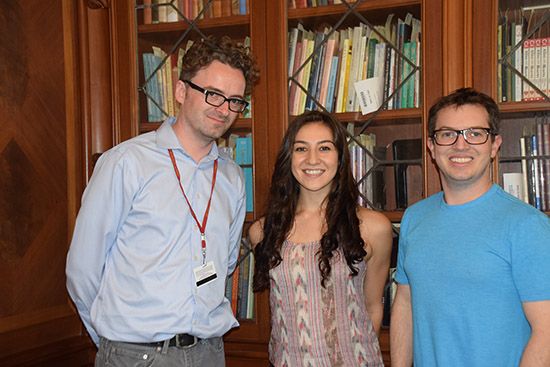Indexing Terms for Emotions Created for JFCS Collection

From left, Crispin Brooks, Syuzanna Petrosyan, and Glenn Fox
By Josh Grossberg
When USC Shoah Foundation began work on the Holocaust testimonies recorded by the Jewish Family and Children Services (JFCS) of San Francisco, a quandary instantly presented itself: Unlike the first set of 52,000 Holocaust testimonies in the Visual History Archive, many of the JFCS interviews were conducted by psychologists who delved deeply into the emotional states of the survivors.
While the original set of testimonies were indexed with more than 60,000 terms, they were mostly based on memories, not feelings. To accommodate the new collection, a new set of indexing terms would have to been researched and developed.
As it happens, a cross-disciplinary group from USC was already on the case. Crispin Brooks, curator of USC Shoah Foundation’s Visual History Archive; Glenn Fox, a postdoctoral scholar at the USC Brain and Creativity Institute; and Syuzanna Petrosyan, then a graduate student, had been having informal discussions on ways to connect emotions with testimony.
When the deal to bring the JFCS collection into the Visual History Archive was made a year ago, the trio was ready for the challenge, and they set to work researching and creating the new appropriate terms. And when the collection makes its public debut this fall, it will accompanied by 30 new searchable words that relate directly to the emotional state of the survivor. New indexing terms include “anger,” “love,” “despair,” “loneliness,” “pride” and “gratitude.”
Brooks said that the people trained to index the testimonies in the JFCS collection – part of a larger drive called Preserving the Legacy that seeks to digitize, index, preserve and integrate testimonies taken by other institutions – only flagged terms that the survivor explicitly referenced. It wasn’t up to the indexers to interpret someone’s mood, but if a survivor talked about their feelings of envy or determination, then those emotions were indexed.
“If somebody says, ‘I remember I was really furious about something,’ and they dwell on that a little bit, that’s the time the term “anger” becomes applicable,” Brooks said. “The interviewee has to talk specifically about that emotion. We’re not asking indexers to diagnose, just to describe what the interviewee describes.”
Precise meanings were of paramount; definitions for emotions as seemingly similar as compassion, empathy and sympathy had to be teased apart. And some emotions worked best when paired with other terms. For instance, one could have pride in their family and pride in their Jewish identity, two similar but difference ideas.
“We had to find a common lexicon for these terms,” Fox said. “In the process of finding commonality, we were enriched by the things we saw.”
The most common emotion expressed in the JFCS collection was “fear.”
Brooks, along with USC Shoah Foundation consultant Ita Gordon, reviewed the work to ensure it complied with the high standards the work demanded.
The approximately 1,400 video testimonies preserved by the JFCS are the first Holocaust testimonies in the Visual History Archive not collected by USC Shoah Foundation. They were collected in a variety of audiovisual formats since the 1980s.